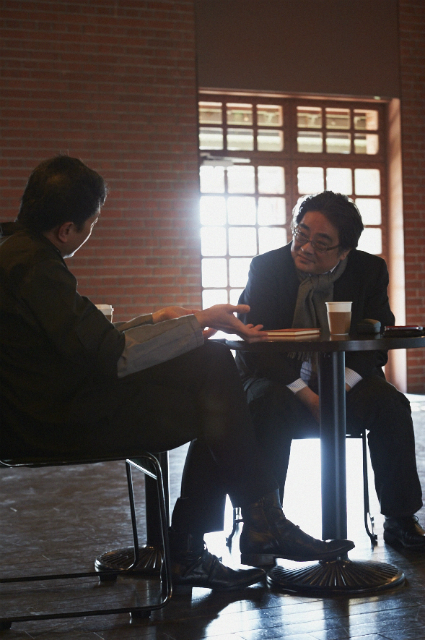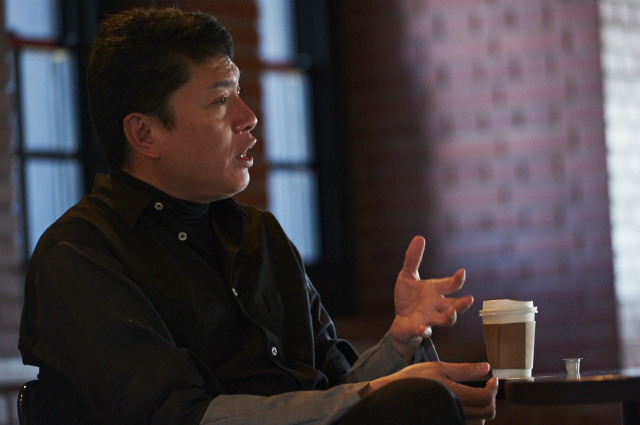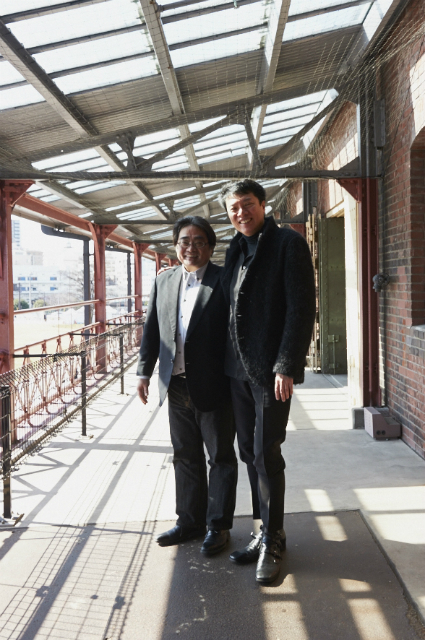Japan and Asia
Uchino: You invited young Asian dancers to participate in DAB. Was that, as you have just said, a way to offer them an opportunity to interact with the different contexts and methodologies of Japanese dance?
Keng Sen: Yes. And through that Japanese artists also consider other contexts, i.e. move out of the box.
Uchino: How long has your relationship been with Japan? Twenty, thirty years?
Keng Sen: Thirty years.
Uchino: How do you see the current state of Japanese performing arts?
Keng Sen: I'd like to share a little story. On our way from Narita to Yokohama, I was chatting with an artist who was going to take part in DAB. "The first time I came here was 1988, were you born?" I said. She replied, "No, I wasn't." I then asked, "when were you born?" "Oh, 1992," she replied. It struck me, then, that I was going to work with artists who were born during the years when I showed important pieces of mine in Japan, like in 1992 or 1997. In terms of the transformation over these thirty years, relationships with senior artists were important in the past, I think. They had ideas of linking together Beijing, Seoul, and Tokyo, and the artists with whom I worked with then searched for commalities, that is a common idea of Asian――back then, it was East Asian――culture.
When I came to Japan on the invitation of the ASEAN Center (which then became the former Asia Center) of the Japan Foundation in 1991, it was important to work with senior artists, for instance in Indonesia or the Philippines. But, now, the younger generations are drawing attention. For example, in Singapore, TheatreWorks my company is welcoming Jun'nosuke Tada to create a dance performance with young artists who work in the city. Many artists in their twenties have been active in Asia, to which TPAM has contributed, and I think that perspectives of Asia are transforming.

Previously, Asia was concerned with exchanges among the older generations. That has changed quite a bit. Japan has lost confidence due to its weakening economy which runs parallel to the rise of other powers and ambitions in Asia, but I would say that there is depth to Japan. Japan has cultivated its own unique vision towards the arts. If there is a branch left as it is in nature, then the Japanese would polish it until its surface shines smoothly. So this simple branch turns into something that is worth, maybe, one million yen. I mean, who else in the world would use a small fan that costs $10,000 for a performance?
Absorbing Chinese music, and then developing the performance in a particular method, is also another type of singularity. Japanese people had the confidence to build a special and deep relationship with what they were interested in. But it seems that this confidence of Japan is being criticized today; it has been seen as a shortcoming rather than an asset. I think that is being lost or neglected from the possibilities of Japanese culture today.
Uchino: Do you think there is a remedy?
Keng Sen: Of course; nationalists and right-wing political parties have been working on it. Balance is important, it has to be healthy. For example, I see this in one of Tony Blair's policies initiated many years ago to re-invent the United Kingdom and therefore to reboot its citizens' sense of national pride. This movement toward regaining national pride emerged as a repercussion of the "dark years" after the Thatcher administration, and, I think, it derived from the need to regain balance, to recover confidence. At the same time, the policy itself was somewhat colonial in character. What I mean by "colonial' here is capitalism, which I think is the greatest colonizer in present-day society. It is necessary to restrict power to a certain degree, and it is just as important to maintain balance: there are many implementations by the Abe administration today, but I feel that there also needs to be a more "humanistic" approach paired with them.
Uchino: Do you mean a more liberal way of thinking? New liberal movements do seem to be emerging in Spain, in Europe, but it also looks, to me, like the return of an obsolete-kind of liberalism. I think we need philosophies that support new liberals. By "humanistic," with regards to the Abe administration and its many "ways", do you mean that Japanese artists can and should build their own, new aesthetics with the methods you just described?
Keng Sen: I would say that cosmopolitanism is an important belief for me; to be "disloyal" to your home cultures. Terayama or Tatsumi Hijikata was disloyal to what was happening in Japan at the time, and it is important to be inspired by these kinds of activities, to be critical of yourself and your involvement——that is, to be self-reflexive. This is sometimes difficult for young people. However, I have met a number of young Japanese artists who have showed me otherwise. So, I would like to support them and give them space to practice disloyalty.

On Dance Archive Boxes
Uchino: Recently, young Japanese artists are showing interest in working with the past or tradition from different approaches. What interested me in the DAB project at TPAM 2016, in this regard, was that the participating choreographers and dancers had the opportunity to revisit their own previous pieces. The project has also been held in Tokyo and Singapore.
Keng Sen: I think that we, as artists and thinkers, haven't focused enough on the potential of modernity because we tend to immediately go back hundreds of years when it comes to the issue of tradition. However, people like Kazuo Ohno or Shuji Terayama already paved the way for finding potentials of modernity. So, what I am proposing is that we could go back a few decades——ten, thirty, or fifty years——not centuries, or not even a hundred years.
World War II obviously transformed the world, which is probably why I can't relate much to the prewar period. Thus, my relationship with traditions is very immediate; it is not in the distant past. DAB became a project to work on the immediate past. I have always said that generations in Asia change in five years, not ten. That's why we say, for example, "okay, here is a work by Mikuni Yanaihara made ten years ago; how can this relate to the present?"
Of course, DAB is a very unique type of archiving: the parameter or rule used is very specific that it does not quite fit the general understanding of archiving. We place importance not on getting our works out as DVDs, but on figuring out what inspired and triggered each of us when working on a piece. During the time when Ikuyo Kuroda created Meeting-Melting, she was expecting but had also experienced the loss of her father; I think this is a psychological aura that no subtext or notation can realize into the piece. DAB, I think, is filled with the possibility of registering and embodying these kinds of pulses and reverberations.
At the same time, as I've mentioned already, self-reflexivity occupies a significant position in my thinking. In DAB, we ask the artist to revisit a particular work of hers/his and to produce an archive box of choice from the reflections. The spacio-temporal "air" of this entire process is condensed within the box, which is then thrown outward——just as someone finds a message in a bottle out at sea which they open and react. I think having another choreographer respond to the box was an important framework, it allowed another artist to react to certain elements but not others, to keep this or that part, but omit others and so on.

So it's very important, in DAB, to not be sidetracked into making art: it's not about figuring out the elements that could make an artwork as that sometimes obscures the process. I think transparency in the DAB's bone structure is more important. I guess you could say that it was my approach to return to a specific singularity, a moment in time and space when the first dance was made and I wanted to incorporate the concept into the project for another choreographer to respond to this, a decade or two later.
These singularities, precisely because they are singular, also have to be made as transparent as possible. They have to be able to explain themselves to the other. So the content of the box is literally made visible to the viewer too. If the end product is taken in without being transparent and is only presented as a new work, it signifies a complete denial of DAB's process itself.
Uchino: How was the chemistry between the Japanese participants and the South Asian artists who received their boxes?
Keng Sen: The respondents to the boxes were——how should I say——a little defensive, at the beginning. The boxes were supposed to transcend culture and the politics inherent in it, but some South Asian choreographers questioned why they had to respond to the Japanese boxes. Then when the responses were presented, some commented that the boxes were being destroyed. My intention was, however, to observe how far and open DAB could push the politico-cultural frameworks of Japan and India outward (I was interested in the meeting of the two dance scenes, the Japanese being a hermetic scene and the Indian dance scene included South Asians and Indian diaspora to form a heterogenous scene). As I said, the boxes are meant to create holes and break down borders, not produce more of them.
In the early stages, Japanese artists exchanged boxes which worked fine, but they got nervous when they were simply asked to give the boxes away. When they came to Singapore, however, they were less anxious and realized that it was, in fact, about copyleft——releasing the boxes to unknown editing, as it were. Many of us involved in the process, myself included, came to understand the importance of letting go——literally and metaphorically——and leaving it to the flow of things. Usually, an artist is considered to be the owner of her/his work, but, here, once the work comes into being, it possesses its own potency and no longer belongs to the individual who had created it.
Uchino: That must be difficult, especially since Japanese artists can occasionally have a strong, emotional, not legal, attachment and therefore sense of ownership to their works.

Keng Sen: It is something that cannot be controlled. For example, the image of Kazuo Ohno's Admiring La Argentina, which has been touring the world, is picked up by a newspaper in, say, Riga, Latvia. A local artist sees the article and image and creates a work inspired by it. That's one way an artwork takes on its own life.
Uchino: That's true. But, that process of appropriation occurs everywhere now. What is interesting in DAB is that it literally makes visible the very process of influence——of both giving and receiving influence——and does so within the restrictions of responding to a specific box. How do you think the project will evolve?
Keng Sen: I hope it will continue to reach more places; it will travel more. It can continue as it is, and possibly have a second iteration maybe in Germany, Denmark, or the United States. As it further removes itself from its "origin," we may perhaps need to provide it a different a framework; we may even want to produce new works out of it and not only have responses.
Singapore International Festival of Arts 2016
Uchino: Lastly, I'd like to return to SIFA. The theme for 2015 was, I believe, "Post Empires." What will it be for 2016?
Keng Sen: "Potentialities."
Uchino: Okay!

Keng Sen: I started the 2014 program with a project called 89plus which looked into the legacy of the past hundred years. There was the start of world digitalization in 1989, and we looked at youth voices who were born after 1989 with Hans Ulrich Obrist. We also examined monopoly capitalism in the POST-EMPIRE period——that is the neoliberal process, the process of authority in present-day society. What follows these are "potentialities;" to deal with that which may be dormant or invisible, just as Kuroda did in Meeting-Melting. DAB was also, in that sense, a ticking time bomb whose explosion could have been positive or negative.
This year, in The Open, I think we are following the potentials of the individuals instead of a specific genre. We are inviting Perhat Khaliq from Urumqi, Xinjiang, to the opening. He is a rock musician who recently won the talent competition——in 2014, I think——and is now seen as the "voice of China." We want to show that, unlike the Chinese government, many don't think of Xinjiang or Urumqi only as the place of terrorists but there is something there. That something is potentiality. We may never know whether the potentiality is truly dangerous. However it allows us to think of the past in the future tense and the many "modernities" as a future because, as I said, modernity quickly passed by in most Asian countries. As globalization quickly shifted to postmodernity, modernity also was bound to come to a pre-mature end.
Uchino: I find it fascinating that, while modernity is considered in a negative light in the West, you are trying to shed a positive light on Asian modernity.
Keng Sen: Correct. I'm trying to see if I can develop the methods for DAB into a larger work of my own, like a porous intercultural piece of theatre which will transform the origins of an "insular" modern artwork.. I'm now directing Hideki Noda's Richard Sandaime, which some critics have viewed negatively. I have quite a degree of empathy for it.
Uchino: Is that for SIFA?
Keng Sen: Yes, but it will premiere in Shizuoka in April 2016. It will then be shown in Singapore and two weeks at the Tokyo Metropolitan Theatre!
Uchino: I look forward to it. Thank you very much.

[Interview conducted at Yokohama Red Brick Warehouse, February 13, 2016
- Pre Brexit, Pre Trump.]
Interview and text: Tadashi Uchino
Born in 1957 in Kyoto. Received an MA in English literature from the Graduate School of Humanities, University of Tokyo. Earned a PhD in 2001. Currently a professor in the Graduate School of Arts and Sciences, Department of Interdisciplinary Cultural Studies, University of Tokyo. Specializes in Japanese and American contemporary theater and performance studies. Among his publications are Melodramatic Revenge (Keiso-shobo, 1996), From Melodrama to Performance (University of Tokyo Press, 2001), Crucible Bodies (Seagull Press, 2009), and Towards Transnational Mobility (University of Tokyo Press, forthcoming). Serves on the board of trustees of the Saison Foundation, the board of directors of Kanagawa Arts Foundation, the board of the Arts Council Tokyo, the ZUNI Icosahedron Artistic Advisory Committee, and the board of directors of the Association for Studies of Culture and Representation.






